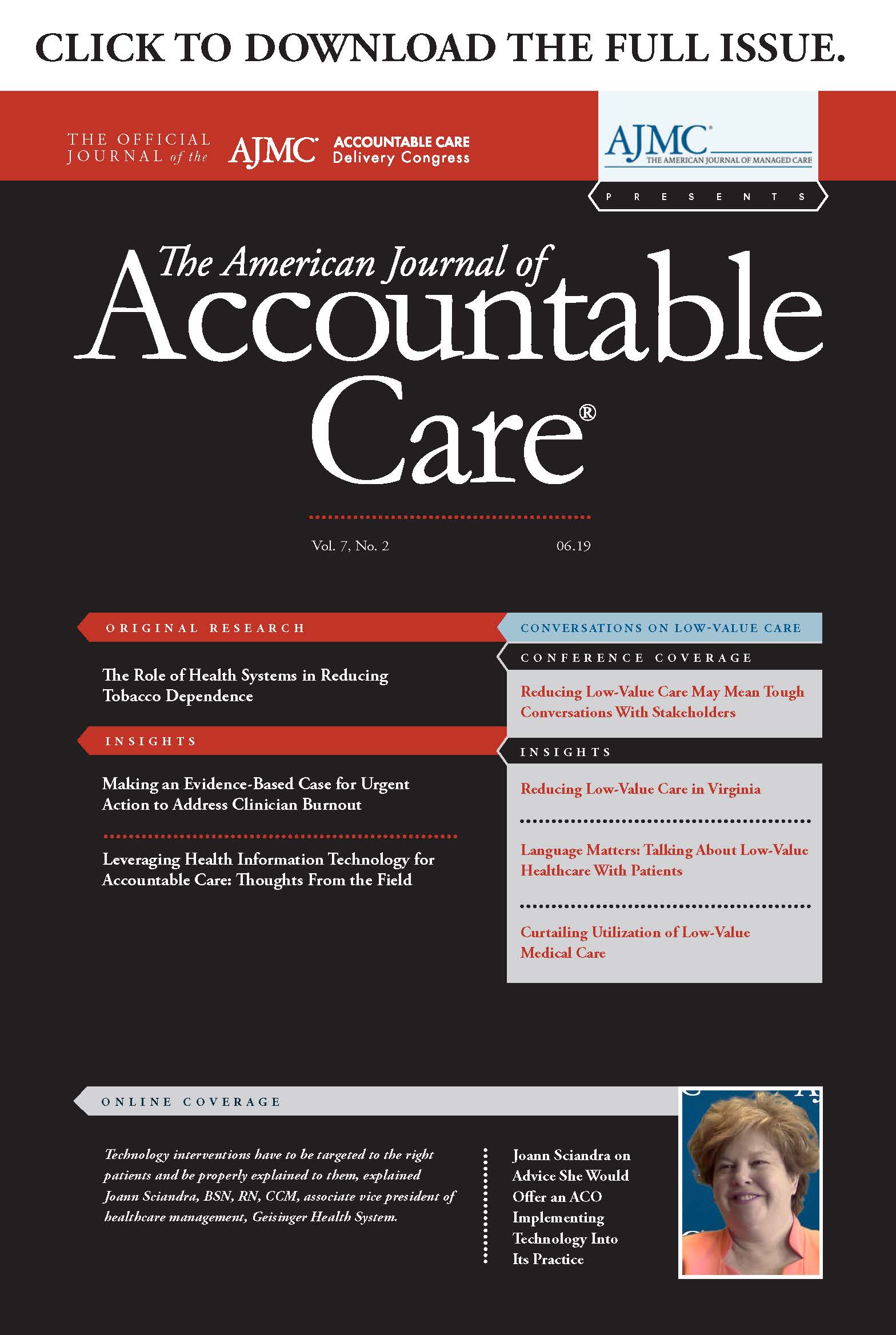- Center on Health Equity & Access
- Clinical
- Health Care Cost
- Health Care Delivery
- Insurance
- Policy
- Technology
- Value-Based Care
Curtailing Utilization of Low-Value Medical Care
Working together to reduce low-value care, stakeholders can help eliminate wasteful spending and deliver on their goal to improve the health of Americans by delivering higher-quality care at lower cost.
The American Journal of Accountable Care. 2019;7(2):24-25We all have an obligation to serve as good stewards of America’s healthcare dollars, and healthcare companies can go further and seize the opportunity to drive systemwide improvements to deliver more value for those we serve. Three years ago, Cigna created a national role dedicated to identifying opportunities to extend healthcare dollars while maintaining or improving the quality of care. (The term “Cigna” as used herein refers to operating subsidiaries of Cigna Corporation including Cigna Health and Life Insurance Company.) This is my role, and I am 100% focused on increasing the value of medical care that customers receive.
Unfortunately, in the United States, medical culture often assumes that more expensive care equates to better care. In fact, studies have shown that higher-quality care may cost less, and our goal as providers and payers of healthcare should be to move the healthcare system to one that is focused on value over volume.1
To do so, we must identify and curtail the use of so-called low-value medical care.2 These are tests, imaging studies, procedures, and medications that lack evidence of improved health outcomes and may even be harmful by leading to needless anxiety or further testing and procedures that carry the risk of complications. Although challenges exist in identifying sources of low-value care, there are several road maps we can follow.
One approach is to monitor the recommendations of the US Preventive Services Task Force (USPSTF), which is part of the federal government’s Agency for Healthcare Research and Quality. USPSTF offers a category D recommendation that is defined as “not recommended” and states, “The USPSTF recommends against the service. There is moderate or high certainty that the service has no net benefit or that the harms outweigh the benefits.”3 As healthcare companies, we can discourage use of these potentially ineffective or harmful practices by incorporating the USPSTF recommendation into appropriate coverage policies. Resulting coverage determinations are balanced by appeal rights that allow for coverage when the potential benefit outweighs the risk for individuals and is deemed medically necessary.
Another source of low-value care identification is Choosing Wisely, a project of the ABIM Foundation.4 More than 80 medical specialty societies and other organizations have contributed lists of medical services to avoid or to at least be subject to a discussion of relative risks and benefits between healthcare providers and patients. These lists can also be utilized as support for coverage and reimbursement policy decisions.
Specialty societies may also address issues of low-value care through clinical guidelines, as was the case in 2015 when the Endocrine Society released guidance regarding routine screening for vitamin D deficiency. The screening had become a widespread practice when the organization came out with guidance that stated, “Screening is recommended for individuals at risk for vitamin D deficiency. Population screening or screening of those not at risk is contraindicated.”5 Based on this position by the professional society of the country’s leading experts in the field, Cigna began a process to examine utilization and found that many customers were receiving this unnecessary and potentially misleading test. Through Cigna’s purposefully cautious and deliberate process, it was determined that we should no longer reimburse vitamin D testing when done as a routine screening in populations not at risk for deficiency. The new policy went into effect in early 2018, and we were the first major healthcare company to adopt this position. Since that time, Cigna has reduced spending on unnecessary vitamin D testing by more than $20 million (Cigna Business Analytics, unpublished data, April 2019).
Ultimately, eliminating low-value care in the US healthcare system will depend in large part on changing healthcare provider behavior. Providers need to be encouraged to monitor and adhere to the recommendations of expert voices like the USPSTF, Choosing Wisely, and their own professional organizations. Healthcare companies need to educate providers and customers alike to question care that is unnecessary or of unproven value. Working together, we can help eliminate wasteful spending and deliver on our goal to improve the health of Americans by delivering higher-quality care at lower cost.Author Affiliation: Cigna, Bloomfield, CT.
Source of Funding: None.
Author Disclosures: Dr Keats is employed as a senior medical director for Cigna and receives a small number of stock shares and options based on employment.
Authorship Information: Concept and design; analysis and interpretation of data; drafting of the manuscript; and supervision.
Send Correspondence to: John P. Keats, MD, Cigna, 900 Cottage Grove Rd, Bloomfield, CT 06002. Email: John.Keats@Cigna.com.REFERENCES
1. Baicker K, Chandra A. Medicare spending, the physician workforce, and beneficiaries’ quality of care. Health Aff (Millwood). 2004;suppl web exclusives:W4-184-W4-197. doi: 10.1377/hlthaff.w4.184.
2. Mafi JN, Russell K, Bortz BA, Dachary M, Hazel WA Jr, Fendrick AM. Low-cost, high-volume health services contribute the most to unnecessary health spending. Health Aff (Millwood). 2017;36(10):1701-1704. doi: 10.1377/hlthaff.2017.0385.
3. Grade definitions. US Preventive Services Task Force website. uspreventiveservicestaskforce.org/Page/Name/grade-definitions. Published October 2018. Accessed April 25, 2019.
4. Choosing Wisely website. choosingwisely.org. Accessed April 25, 2019.
5. Endocrine Society published clinical practice guidelines for vitamin D deficiency. Healio website. healio.com/endocrinology/practice-management/news/online/%7Bf7557f26-0d85-4ec8-a33a-ef05f41e0e94%7D/endocrine-society-publishes-clinical-practice-guidelines-for-vitamin-d-deficiency. Published September 3, 2015. Accessed April 25, 2019.

Blister Packs May Help Solve Medication Adherence Challenges and Lower Health Care Costs
June 10th 2025Julia Lucaci, PharmD, MS, of Becton, Dickinson and Company, discusses the benefits of blister packaging for chronic medications, advocating for payer incentives to boost medication adherence and improve health outcomes.
Listen
HEDIS Glycemic Goal Achieved Using Control-IQ Technology
December 22nd 2025A greater proportion of patients with type 1 diabetes who used automated insulin delivery systems vs multiple daily injections achieved the Healthcare Effectiveness Data and Information Set (HEDIS) glycemic measure.
Read More

